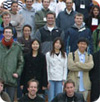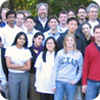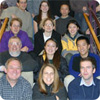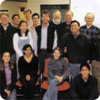Test2
From 2006.igem.org
(Difference between revisions)
| (14 intermediate revisions not shown) | |||
| Line 1: | Line 1: | ||
| - | + | == Previous Years == | |
| + | {|border="0" cellpadding="6" cellspacing="0" | ||
| + | !width=100px style="valign:top"| | ||
| + | !width=30px style="valign:center"| | ||
| + | !width=600px style="valign:top"| | ||
| + | |- | ||
| - | + | |[[Image:2005-logo.jpg]] | |
| + | |'''2005''' | ||
| + | |In the summer of 2005, the iGEM competition became an international event. A record 13 teams worked on projects involving chemotaxis regulation systems, cell-cell genetic communications systems, cellular/biological wires, thermometers, biological sketch pads (drawing systems), cellular relay races, a digital counter, and more. [[Igem 2005|Read more]] | ||
| - | + | |- | |
| - | + | |[[Image:2004-logo.jpg]] | |
| + | |'''2004''' | ||
| + | |This year marked the first true Synthetic Biology Competition. Teams from five schools competed to build cellular state machines and counters. The teams came together for a ''jamboree'' in early November to compare their results. The most graphic project was "photographic biofilm" that could capture an image (now called ''coliroid film''). [[Igem 2004|More]] | ||
| - | + | |- | |
| - | + | |[[Image:2004-iap.jpg]] | |
| + | |'''2004''' | ||
| + | |During MIT's Independent Activity Periods (IAP), MIT-based teams designed genetic systems to create cellular patterns varying from bull’s-eyes to polka dots, and even dynamic designs where cells would swim together. From these designs, many standard biological parts (BioBricks) were designed and synthesized. [[Iap 2004|More]] | ||
| - | + | |- | |
| + | |||
| + | |[[Image:2003-iap.jpg]] | ||
| + | |'''2003''' | ||
| + | |During the 2003 IAP, students designed biological oscillators coupled to fluorescent reporters. These genetic blinkers were intended to improve on Elowitz's Repressilator. One team coupled two oscillators to even out the oscillations. Another used cell-cell signaling to coordinate the oscillators in a colony. [[Iap 2003|More]] | ||
| + | |||
| + | |- | ||
| + | |} | ||
| + | <hr> | ||
| + | [[iGEM_staff|The people behind iGEM]] | [[iGEM_contact|Contact us]] | ||
| + | <hr> | ||
| + | <font size=1; color="LightSlateGray">iGEM Competition c/o 32 Vassar Street, Room 314, Cambridge, MA 02139 (617) 258 5244 | <font size=1; color="Green"> Join iGEM </font> | Support iGEM | [[Main_Page|Home]]</font> | ||
Latest revision as of 19:05, 14 August 2006
Previous Years

| 2005 | In the summer of 2005, the iGEM competition became an international event. A record 13 teams worked on projects involving chemotaxis regulation systems, cell-cell genetic communications systems, cellular/biological wires, thermometers, biological sketch pads (drawing systems), cellular relay races, a digital counter, and more. Read more |

| 2004 | This year marked the first true Synthetic Biology Competition. Teams from five schools competed to build cellular state machines and counters. The teams came together for a jamboree in early November to compare their results. The most graphic project was "photographic biofilm" that could capture an image (now called coliroid film). More |

| 2004 | During MIT's Independent Activity Periods (IAP), MIT-based teams designed genetic systems to create cellular patterns varying from bull’s-eyes to polka dots, and even dynamic designs where cells would swim together. From these designs, many standard biological parts (BioBricks) were designed and synthesized. More |

| 2003 | During the 2003 IAP, students designed biological oscillators coupled to fluorescent reporters. These genetic blinkers were intended to improve on Elowitz's Repressilator. One team coupled two oscillators to even out the oscillations. Another used cell-cell signaling to coordinate the oscillators in a colony. More |
The people behind iGEM | Contact us
iGEM Competition c/o 32 Vassar Street, Room 314, Cambridge, MA 02139 (617) 258 5244 | Join iGEM | Support iGEM | Home